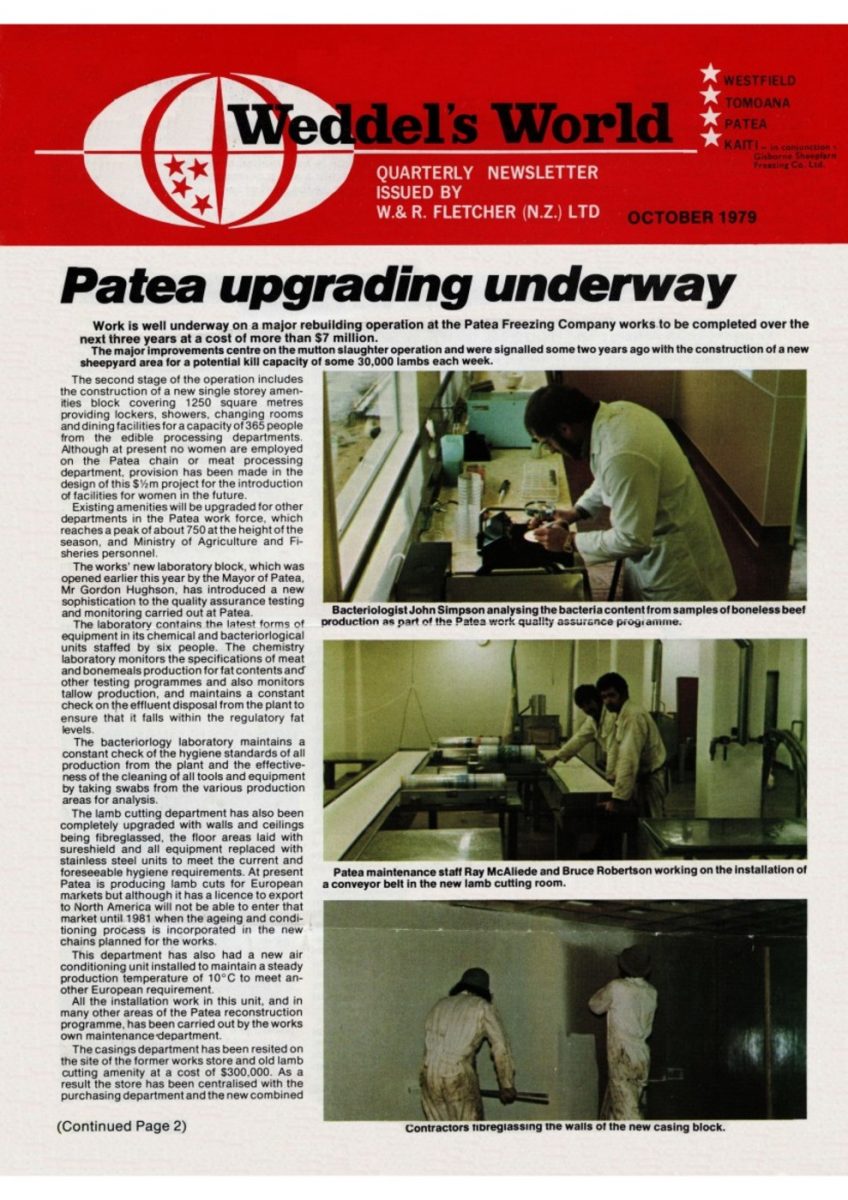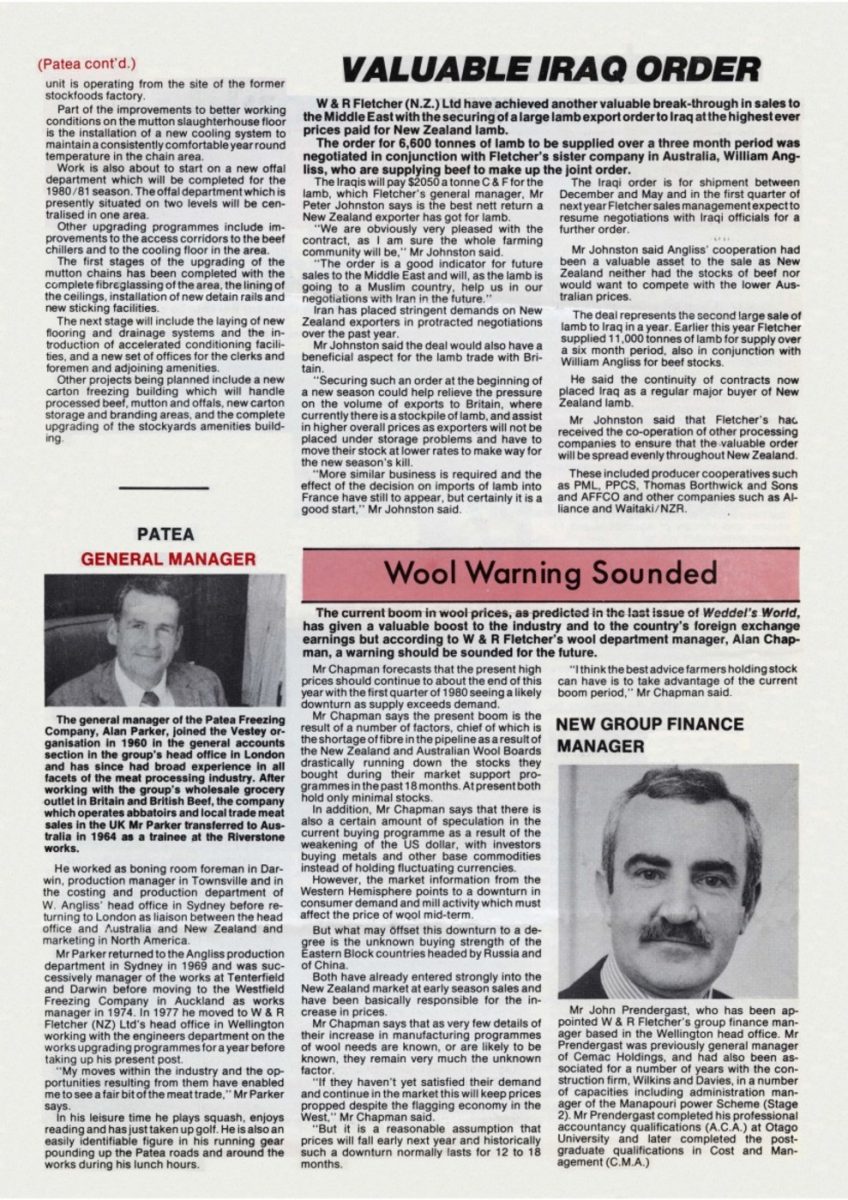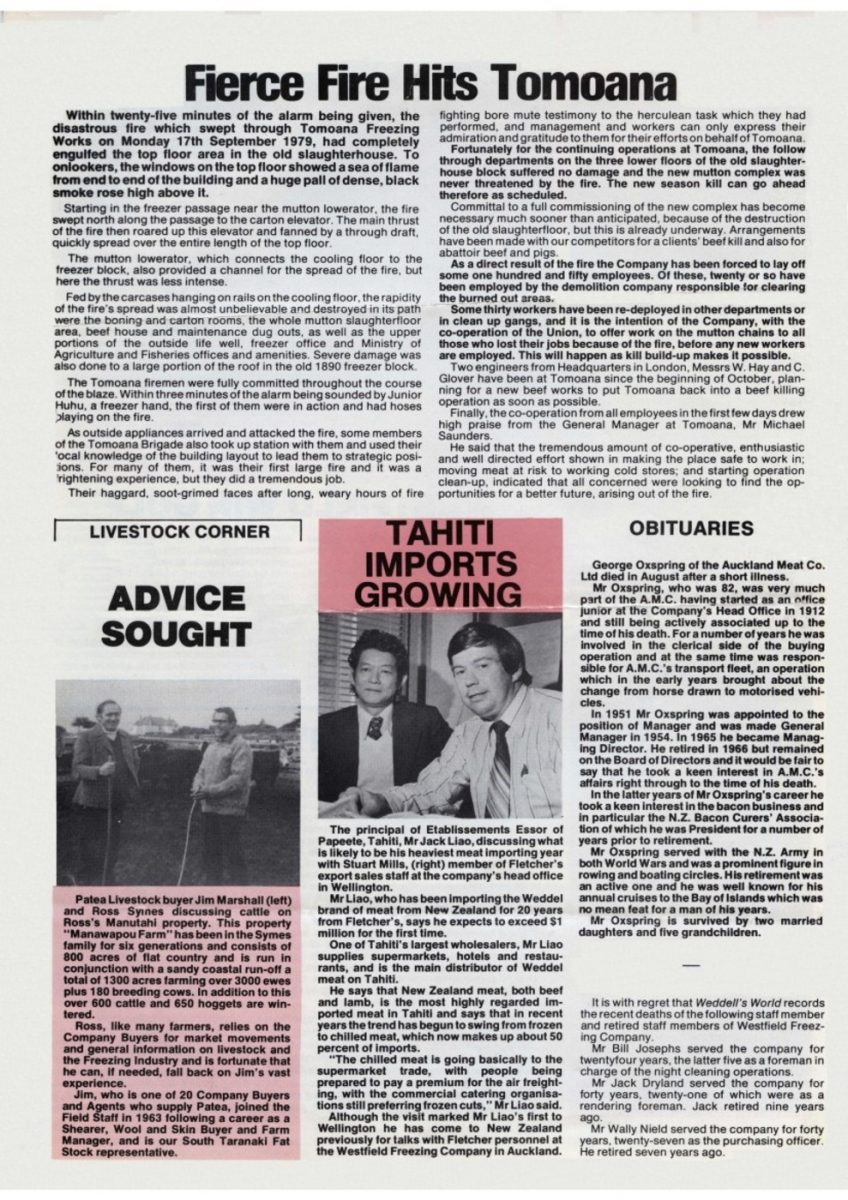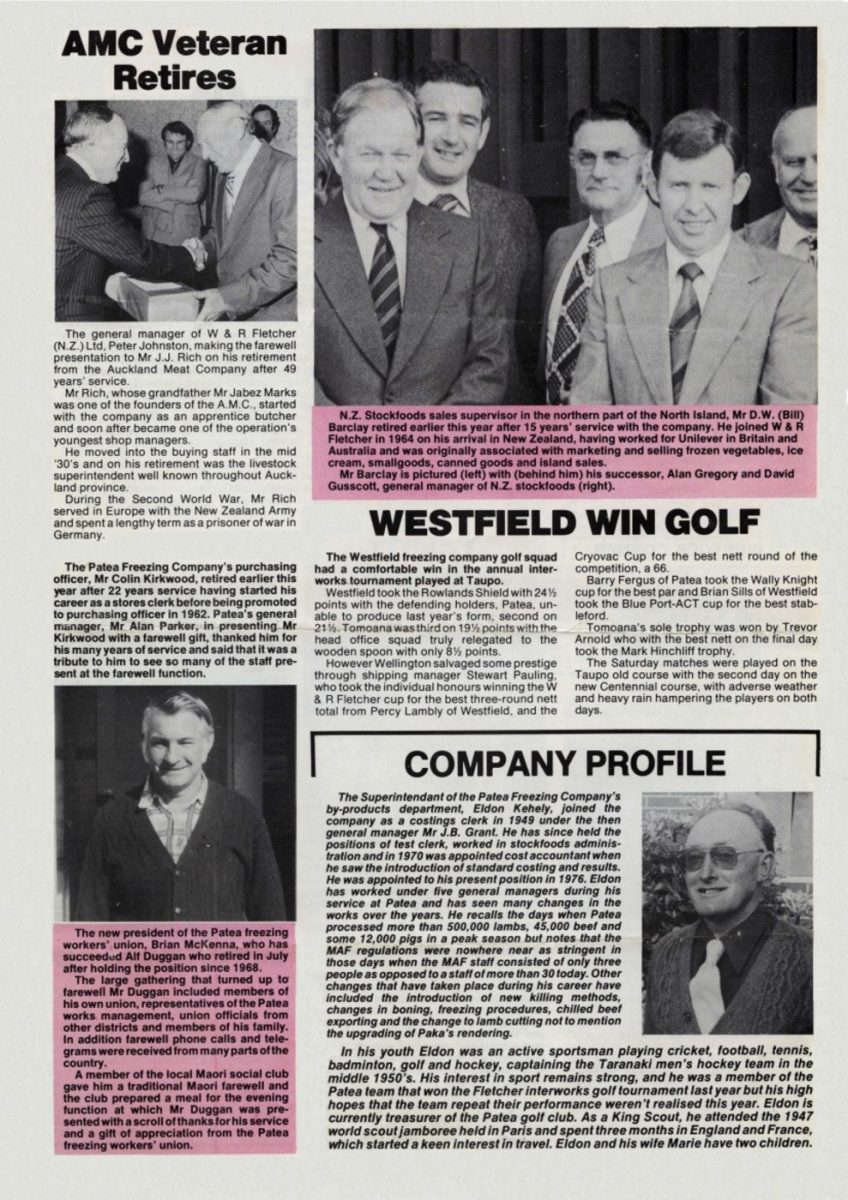Fierce Fire Hits Tomoana
Within twenty-five minutes of the alarm being given, the disastrous fire which swept through Tomoana Freezing Works on Monday 17th September 1979, had completely engulfed the top floor area in the old slaughterhouse. To onlookers, the windows on the top floor showed a sea of flame from end to end of the building and a huge pall of dense, black smoke rose high above it.
Starting in the freezer passage near the mutton lowerator, the fire swept north along the passage to the carton elevator. The main thrust of the fire then roared up this elevator and fanned by a through draft, quickly spread over the entire length of the top floor.
The mutton lowerator, which connects the cooling floor to the freezer block, also provided a channel for the spread of the fire, but here the thrust was less intense.
Fed by the carcases hanging on rails on the cooling floor, the rapidity of the fire’s spread was almost unbelievable and destroyed in its path were the boning and carton rooms, the whole mutton slaughterfloor area, beef house and maintenance dug outs, as well as the upper portions of the outside life well, freezer office and Ministry of Agriculture and Fisheries offices and amenities. Severe damage was also done to a large portion of the roof in the old 1890 freezer block.
The Tomoana firemen were fully committed throughout the course of the blaze. Within three minutes of the alarm being sounded by Junior Huhu, a freezer hand, the first of them were in action and had hoses playing on the fire.
As outside appliances arrived and attacked the fire, some members of the Tomoana Brigade also took up station with them and used their local knowledge of the building layout to lead them to strategic positions. For many of them, it was their first large fire and it was a frightening experience, but they did a tremendous job.
Their haggard, soot-grimed faces after long, weary hours of fire fighting bore mute testimony to the herculean task which they had performed, and management and workers can only express their admiration and gratitude to them for their efforts on behalf of Tomoana.
Fortunately for the continuing operations at Tomoana, the follow through departments on the three lower floors of the old slaughterhouse block suffered no damage and the new mutton complex was never threatened by the fire. The new season kill can go ahead therefore as scheduled.
Committal to a full commissioning of the new complex has become necessary much sooner than anticipated, because of the destruction of the old slaughterfloor, but this is already underway. Arrangements have been made with our competitors for a clients’ beef kill and also for abattoir beef and pigs.
As a direct result of the fire the Company has been forced to lay off some one hundred and fifty employees. Of these, twenty or so have been employed by the demolition company responsible for clearing the burned out areas.
Some thirty workers have been re-deployed in other departments or in clean up gangs, and it is the intention of the Company, with the co-operation of the Union, to offer work on the mutton chains to all those who lost their jobs because of the fire, before any new workers are employed. This will happen as kill build-up makes it possible.
Two engineers from Headquarters in London, Messrs W. Hay and C. Glover have been at Tomoana since the beginning of October, planning for a new beef works to put Tomoana back into a beef killing operation as soon as possible.
Finally, the co-operation from all employees in the first few days drew high praise from the General Manager at Tomoana, Mr Michael Saunders.
He said that the tremendous amount of co-operative, enthusiastic and well directed effort shown in making the place safe to work in; moving meat at risk to working cold stores; and starting operation clean-up, indicated that all concerned were looking to find the opportunities for a better future, arising out of the fire.
LIVESTOCK CORNER
ADVICE SOUGHT
Patea Livestock buyer Jim Marshall and Ross Symes discussing cattle on Ross’s “Manutahi” property. This property “Manawapou Farm” has been In the Symes family for six generations and consists of 800 acres of flat country and is run in conjunction with a sandy coastal run-off a total of 1300 acres farming over 3000 ewes plus 180 breeding cows. In addition to this over 600 cattle and 650 hoggets are wintered.
Ross, like many farmers, relies on the Company Buyers for market movements and general information on livestock and the Freezing Industry and is fortunate that he can, if needed, fall back on Jim’s vast experience.
Jim, who is one of 20 Company Buyers and Agents who supply Patea, joined Field Staff in 1963 following a career as a Shearer, Wool and Skin Buyer and Farm Manager, and is our South Taranaki Fat Stock representative.
TAHITI IMPORTS GROWING
The principal of Etablissements Essor of Papeete, Tahiti, Mr Jack Liao, discussing what is likely to be his heaviest meat importing year with Stuart Mills, (right) member of Fletcher’s export sales staff at the company’s head office in Wellington.
Mr Liao, who has been importing the Weddel brand of meat from New Zealand for 20 years from Fletcher’s, says he expects to exceed $1 million for the first time.
One of Tahiti’s largest wholesalers, Mr Liao supplies supermarkets, hotels and restaurants, and is the main distributor of Weddel meat on Tahiti.
He says that New Zealand meat, both beef and lamb, is the most highly regarded imported meat in Tahiti and says that in recent years the trend has begun to swing from frozen to chilled meat, which now makes up about 50 percent of imports.
“The chilled meat is going basically to the supermarket trade, with people being prepared to pay a premium for the air freighting, with the commercial catering organisations still preferring frozen cuts,” Mr Liao said.
Although the visit marked Mr Liao’s first to Wellington he has come to New Zealand previously for talks with Fletcher personnel at the Westfield Freezing Company in Auckland.
OBITUARIES
George Oxspring of the Auckland Meat Co. Ltd died in August after a short illness.
Mr Oxspring, who was 82, was very much part of the A.M.C. having started as an office junior at the Company’s Head Office in 1912 and still being actively associated up to the time of his death. For a number of years he was involved in the clerical side of the buying operation and at the same time was responsible for A.M.C.’s transport fleet, an operation which in the early years brought about the change from horse drawn to motorised vehicles.
In 1951 Mr Oxspring was appointed to the position of Manager and was made General Manager in 1954. In 1965 he became Managing Director. He retired in 1966 but remained on the Board of Directors and it would be fair to say that he took a keen interest in A.M C.’s affairs right through to the time of his death.
In the latter years of Mr Oxspring’s career he took a keen interest in the bacon business and in particular the NZ. Bacon Curers’ Association of which he was President for a number of years prior to retirement.
Mr Oxspring served with the N.Z. Army in both World Wars and was a prominent figure in rowing and boating circles. His retirement was an active one and he was well known for his annual cruises to the Bay of Islands which was no mean feat for a man of his years. Mr Oxspring is survived by two married daughters and five grandchildren.
It is with deep regret that Weddell’s World records the recent deaths of the following staff member and retired staff members of the Westfield Freezing Company.
Mr Bill Josephs served the company for twentyfour years, the latter five as foreman in charge of the night cleaning operations.
Mr Jack Dryland served the company for forty years, twenty-one of which were as a rendering foreman. Jack retired nine years ago.
Mr Wally Nield served the company for forty years, twenty-seven as the purchasing officer. He retired seven years ago.















Do you know something about this record?
Please note we cannot verify the accuracy of any information posted by the community.